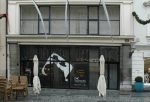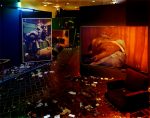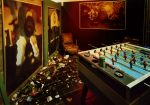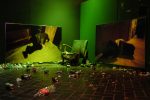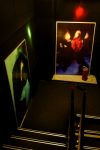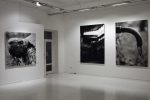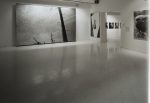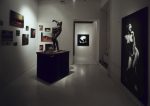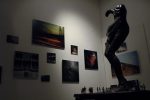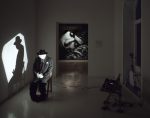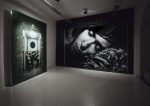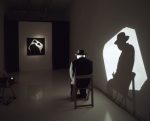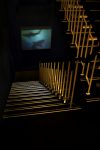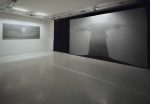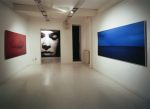Razstava / Exhibition
Odprtje: Ponedeljek, 17. November, 2008 ob 19h in traja do 17. Decembra, 2008
Opening: Monday, 17th of November, 2008 at 7 pm and open until 17th of December, 2008
Lokacija / Location: Mestna galerija 1, Ljubljana
Aleksander Bassin
Lovljenje ritma
V znaku avre DK
“Mislim, da avra pripada fotografiji kot mediju zato, ker fotografija obsega bistven odnos do realnosti zunaj nje same – tj. do fotografiranega objekta – in je torej ne moremo nikoli reducirati na njo samo. Še več, morda bi lahko rekli, da nekatere vrste motivov – kot so obraz, dogodek ali kraj – bistveno pripadajo mediju, saj najjasneje opozarjajo na njegovo avratično razsežnost.”
Mislim, da lahko najdemo nenavadno vzporednost med konceptom avre (oddaljene bližine, bližnje oddaljenosti) in Freudovim konceptom grozljivega (dasUnheimliche). Freud je poskušal pojasniti svoje razumevanje tega koncepta z etimologijo besede ‘unheimlich’, ki pomeni tuje, grozljivo, ‘nedomače’, a v nekaterih primerih tudi ‘domače’. Tako ta koncept implicira dialektiko tujega in domačega, bližnjega in daljnega. Nekaj imamo za tuje, grozljivo, ‘nedomače’ prav zato, ker nam je v bistvu domače, ker se tiče nečesa, kar vse predobro vemo, a nočemo pripoznati. Mislim, da paralelizem teh konceptov preprosto ni naključen. Oba temeljita na isti ‘formi’: oddaljenost v prisotnosti in prisotnost v oddaljenem.”1
“Zelo nerad bi zašel v kopiranje samega sebe in ponavljanje enega in istega serijala. Verjamem, da so minili časi, ko bi kdo od mene zahteval izključno enoznačno delo, da bi ga lažje uvrstil v filozofski, kuratorski okvir. Umetnost ne sme in tudi ne more biti zbanalizirana zgolj na področje racionalnega.”2
Fotografiji avtorja, ki svoja dela podpisuje z DK (pri čemer je popolnoma irelevantno, za katero izbrano delo oz. za katero motivno vsebino gre), zanesljivo pripada avratična razsežnost; razsežnost, ki je seveda in zlasti svojska samó (tistemu) avtorju fotografije, za katero stoji osebnost s posebnim, izdelanim izraznim odnosom do izbranega motiva. DK sam je mnenja, da odkriva s pomočjo medija v svojem delu tenzijo: “S tenzijo mislim napetost, zven oz. vibracijo, ki jo moje fotografije nosijo v sebi. Preko nje lahko gledalec zazna avtorstvo ne glede na sámo pojavnost dotičnega dela. Gre za prepoznavanje avtorjevega odnosa, nazora preko njegovih del (oz. preko njegovega izraza). Gre za pečat, ki ga puščam skozi interpretacijo, ne glede na to, da ustvarjam ‘… z obiljem pristopov, ki govorijo o potencialu fotografske podobe kot oblike in družbene vsebine”3
In prav v tem avtorjevem preskakovanju, bolje: izbiranju, je mogoče (z naše strani) vedno občutiti tisto posebno izrazno povezanost, zaradi katere se DK razlikuje od svojih sodobnikov: tako v določanju izbranih dogodkov, trenutkov, prostorov in časa v njih, v zbliževanju realnosti motiva in realnosti fotografije, v poudarjanju (zelo pogosto) socialne komponente; vse to v slogovno prepoznavni medijski transkripciji, ki vedno prikriva nekaj tistega ‘Unheimlich’, ko gre tako za akcentuirano kot za intenzivno črno barvitost (pri črno-beli fotografiji) oz. ko se v njegovi barvni fotografiji razkrije prava, brezsramna naglašenost vsakodnevne realnosti, sicer navidez utopljene v časovnem zatišju, ki pa notranje pulzira in tudi udari navzven spet v tisti nelagodni razsežnosti.
Skozi ves svoj fotografski opus DK torej sledi tisti izraznosti, v kateri zelo občutno prepoznavamo avtorjevo zanimanje za predstavljanje posamične in skupne identitete hkrati, in to v kontekstu, ko nastajajo posnetki tako v studiu kot v urbanem prostoru (pod pojem ‘urbanost’ velja šteti vsako avtorjevo interpretiranje dogajanja na prostem).
Zaustavimo se najprej pri fotografijah iz serije Trn (2003), ki jih DK predstavi v izgrajenem simuliranem prostoru (beznice), kot so bile posnete v realnosti: to je dokument o mladih in njihovem pobegu v svet psihične osamljenosti. Kot posledica le-te se odkriva problematika droge, ki je razširjena med mladimi v tistem njihovem biološkem času, ko bi morali biti sicer na socializacijskem višku. To je po avtorjevih besedah njegov dokument o vsakokratnem kolapsu v osamo. Vendar je tudi odraz določenega stanja slovenske družbe. To so neposredni, neinscenirani posnetki zasvojenosti, predajanja utopičnim sanjam, ki na najbolj krut način uničujejo mlada slovenska življenja. Že omenjena brezsramna barvita naglašenost teh v klopčič zvitih, anonimnih in neprepoznavnih človeških teles v avtorjevi interpretaciji stopnjuje zamrlo dogajanje do avratične absurdnosti.
V črno-beli seriji Animal predstavlja DK emocionalno izredno mehka, skoraj lirsko razpeta (in le na trenutke na bizarno noto ubrana) dogajanja, katerih protagonisti so dejansko živali. Postavlja jih oz. preko njih izhaja v neko novo (nad)realnost, ki ostaja v njegovem opusu svojevrstno poudarjena, sicer pa izjema. Te fotografije so nastajale v obdobju 1990–97.
Slon (1990) je posnet v Pragi; gre za samca, ki je v ujetništvu razvil avtistične poteze in ki naganja obiskovalce. Daje nam vedeti, da mu je njegova zasužnjenost zaradi našega užitka oz. lagodja povsem jasna. Kaj pa si misli o nas, pove, ko nas obmetava z iztrebki, odpadki … Tolažimo se, da žival tega ne počne zavestno, nalašč … “Tojenašazmotainarogancahkrati.”
Grozljiv je zgornji del slike, kjer je iz oken sestavljen širok nasmeh, medtem ko je v spodnjem poudarjena črnina, odsotnost živega in se slon, če ne gledamo dobro, izgubi v sivini betona svoje ujetosti. Kar smo naredili slonu, lahko naredimo soljudem v še hujši obliki.
Ribaizpipe (1990) govori o stanju vode in okolja, o brezizhodnem položaju živali in začetku pospešenega izumiranja živalskih vrst. “Človeku so se živali približale, ker jim primanjkuje življenjskega prostora, zato prihaja do bizarnih pojavov, do nekih dvoumnih situacij.” DK prepušča razlago vsakemu posamezniku, “vendarjedejstvo,dajenaslikinekajzelonarobe,čepravjelogična”.
Nebo z rojem ptičev na fotografiji Wishes (1997) je kot predrto s šrapnelom, Tartuga (1992) pa učinkuje (v svoji povečavi) kot začetni ‘nelagodni’ portret, tako rekoč napoved avtorjeve serije Lice.
Človeško telo DK le redko zajame v celoti: to kaže diptih Human – moški in ženski akt v ekspresivno zvrnjeni pozi in zastalem kriku, sicer pa v naravni velikosti.
Zaradi svoje nepopolnosti kričita eden na drugega; tako sta si usojena, zunaj svoje odločitve, ne da bi zmogla (duhovno) prerasti v eno bitje.
Brezosebna, neopredeljena, sicer oblečena lutka s svojo senco v umišljenem okviru pod naslovom TheBigWait (pozimi 1990/91) je vredna posebne omembe v avtorjevem delu – morda prav kot napoved njegovega odnosa do uvodoma omenjenega odkrivanja kolektivne identitete. “Kvadrat kot simbol zemeljskega. Postavljen v romb kot svojo najbolj dinamično obliko, kjer je jasno, da se bo prevrnil na eno ali drugo stran. In mi čakamo, kot bi se nas ne dotikalo. Praznoglavi in lepo urejeni … S tem delom kot da sem opravil z družbeno stupidnostjo.” DK kolektivno identiteto nekako znova obnovi, razširi v delih, kot je TheBigSleep. Hermafroditski obraz z nadrealnim pridihom, ob licu katerega se gosti skupek brezimnih mrličev, ki se ga vsako noč uporabi ‘za vzglavje’. Personifikacija našega mirnega spanca se kaže v paradoksalnosti mnoštva človeških trupel.
Tu je še TheBigBreak, inscenirana fotografija s prostorsko izvedeno instalacijo dvigala – uslužbenci na poti na kosilo končajo zaplinjeni v dvigalu. “Živimokotvtaborišču;nezaradikonspiracije,temvečzaradipritlehnegapohlepa.”
Po vsebini sodi sem tudi posebej zanimiv avtorjev kiparski intermezzo Malik (izvedba kiparja Marka A. Kovačiča). Ponazarja umirjajoči kolos v obliki želodca, ki ga malikuje ob vznožju se zgrinjajoča množica turistov (sodobne industrijske serijske igračke), zazrta v bleščeč Malikov nožni palec, kot pri božanstvih v svetiščih zloščen od številnih dotikov, od katerih naj bi vsak izpolnil željo.
V svoji medijski koncentraciji pa DK zlasti obvladuje serijo Lice, ki v značilnem gornjem rezu in kontrastni (spet poudarjeno črni) svetlobi zakriva oz. se razlije po eni strani portretirančevega obraza. “Tiobrazisosodobniurbanipirati.”4 Prvotno so to samo znanci, umetniki in sočasno prebivalci Metelkove mesta, katerih podobe so doživele, stalno predstavljene na obzidju nekdanje vojašnice, tudi svojevrstne (grafitne, urezne) intervencije; v nadaljevanju je DK na portretih priznanih (zlasti) glasbenikov in drugih (slovenskih) ustvarjalcev dosegel novo, karakterno poglobljeno, okamenelo togost in zadržanost, ki posega ponovno na področje estetike nelagodja. “V procesu izmenjave pogledov med gledalci, portretiranimi obrazi in nami gre vselej za nekakšno slepoto. Videnje je vedno stvar pristranskega dejanja gledanja”.4
Najnovejše Velikeslike so “citiranjestrukturneganasiljakot(nepovratnega)zdrsa … nezaupnicadružbenistrukturi,napaki,kijočloveštvoponavlja … soneprizadetoopazovanjeinnaštevanjedejstev…”, po intenziteti pa nadaljevanje za avtorja značilnega subjektivnega, družbeno angažiranega opusa. Ali kot ponazori ta čas v eni od pesmi njegov prijatelj pesnik (izvrsten je njegov ‘okameneli’ fotografski portret!): “/Potempadamo,/vsikrhki,nebogljeni/inbrezkril,/innititeganevemo,/česmosenakoncu/splohsposobniujetinanoge/invskladussvojim/nacionalnimkarakterjem/pokončnoodreagirati/nacelotenspisek/nestrpnihskušnjav./Prihajajohladničasi.Obdobjeopazovanja/inotipavanja./Časočiinkože./”5
V seriji War smo priča tudi sledem prave vojne vihre – portretom ljudi (med njimi naredi DK sodobno paralelo CigankiIlla2 pokojnega fotografa Jožeta Kološe iz leta 1946) in dekonstruiranih prostorov ter razbitin – realnosti, ki je bila bistveno drugačna nekoč, kot je sedaj, ko jo vidimo na fotografiji.
In kakšen je avtorjev, lahko bi zapisali skoraj himničen razstavni zaključek? Ob tem ko se zavedamo, da je poleg serije, ki se je začela s fotografijo BigWait, nadaljevala z The BigBreak in The BigSleep (le-ta še nastaja), DK izbral še fotografije iz serije Silent, ki so spet izrazito barvite, različne v motiviki, pogreznjene v nadrealni sen in daljne, umišljene horizonte …
Travmatično sledenje nelagodnemu ostaja v teh vizualnih ‘avtomatizmih’ nenehno navzoče tudi v tej najnovejši seriji: tudi v navidez lepih horizontih, nastalih ob organski vihri, v sledi krvi na stopnicah, ki jo zamenjujejo za sončne zahode, in nazadnje tudi v delu The BigSadland, pejsažu človeških trupel, posejanih v vodi … “Nočjeinnadesetine/majhnihmrtvihsonc/sepozibavavčrnivodireke,/kijeoddalečgladka/inskrivnostna/kotkoža.”6
1. Igor Zabel, katalog Kraji, Moderna galerija, Ljubljana, 1994.
2. Ta in drugi citati brez navedbe vira so iz mojih pogovorov z DK.
3. Marina Gržinić, katalog Trn, Strip Core / Forum Ljubljana, Ljubljana 2003.
4. Obe navedbi v tem odstavku: Marina Gržinić, ibid.
5. Tone Škrjanec, Novičasi, pesniška zbirka Baker, založba Šerpa, Ljubljana, 2004.
6. Tone Škrjanec, Nočvnoči, ibidem.
Marina Gržinić
DK: Vse – in še več
Napisati tekst za monografsko predstavitev avtorja, zlasti ko je ta v polnem ustvarjalnem teku in ker katalog/knjiga ne bo zaključek njegovega življenjskega opusa, temveč bo šele začetek relevantne razprave o tisti edini pravi stvari – fotografiji –, je izjemno zahtevna naloga. In obenem toliko zapletenejša, saj se DK predstavlja skozi razstavo in knjigo drugače, kot smo bili vajeni doslej. Tokrat v neki totalnosti in razpršeni mnogoterosti, ki od nas, gledalcev in piscev, zahteva, da pustimo doma običajno razglabljanje o žanru fotografije, o tem ali onem ciklusu, od portretnega do dokumentarnega in nazaj. Zdajšnji DK zahteva od samega medija, prakse, polja, estetike in poslanstva fotografije vse – in še več: tako rekoč ‘svet’, ki naj bi ga fotografija predstavljala. V tej knjigi in na razstavi gre za vprašanje o samem smislu fotografije, ali drugače rečeno, o tem, ali ima fotografija še kakšno moč, globljo filozofijo, zavezujočo pripoved. DK raziskuje temeljno vprašanje, ali lahko v današnjem svetu, ki je že itak naveličan podob zaradi njihove preobilice, naredimo s fotografijo še kaj več? Ali je fotografija še lahko vznemirljiva, transcedentna?
DK od fotografije ne zahteva žanrske razvrstitve, pač pa dobesedno njeno ‘dušo’.
V ta namen fotografijo razcepi od znotraj, vanjo in z njo vpelje razsežnost fantomskega, spektralnega. DK poskrbi, da postane sedanja domačnost fotografije varljiva. V trenutku, ko se nam zazdi, da nas nič več ne more presenetiti ali zmotiti, nam s svojim pristopom k ‘recikliranju’ in preurejanju fotografskega polja ter prostora okrog fotografije le-to predstavi kot tujko, oddaljeno in varljivo. Grozljiva tujost se pokaže vsakič, ko se brišejo meje med imaginacijo in realnostjo in se tisto, kar smo šteli za fantastično, ponudi kot realno; ko simbol prevzame pomembnost in moč tistega, kar je simboliziral,1 “deluje tako, da učinkovito in sistematično reificira vse te podobe in nam onemogoča, da bi sprejemali reprezentacijo brez vključevanja predhodno osvojenega znanja oziroma dokse – nekaj, kar nam daje občutek déja-vu, samosvojo domačnost, za katero je človek v skušnjavi, da bi jo povezal s Freudovo ‘vrnitvijo potlačenega’ v Das Unheimliche”.2
V osnovi fotografskega optičnega dispozitiva je obsedenost z ujetjem refleksov, odsevov. Če je rojstvo podobe delno povezano s smrtjo (podoba /gr. eidolon, eidos/ ali uzrtje duše, ki po smrti vzleti, odleti (…) pod obliko nenasitne sence), je projicirana podoba neposredneje kot vse druge povezana z magično operacijo ustvarjanja dvojnikov. “Podoba je senca in senca je splošni naziv za dvojnika.”3 Fotografija kot velika umetnost svetlobe in sence4 tako že vsebuje osnove metafizike simulakra, ki je posledica neskončnih ‘flashbackov’ in reminiscenc na pretekli čas, ki ga s simulirano projekcijo fotografije prenašamo iz sedanjosti v prihodnost.
Najnovejše fotografije DK – Vojna, The Big Break, The Big Sleep, Silent – so fantomske podobe: nagovarjajo nas neposredno in hkrati posredno; so nam blizu, a urejene tako, da učinkujejo tuje, spektralno in varljivo. Ko se nas dotaknejo, so bolj ali manj prikazni. Čeprav so nam bile nekoč znane in blizu, jih dojemamo kot oddaljene in tuje. A natanko v razkolu in zrežirani tujosti fotografije je morda danes najti smisel fotografije, ki presega tudi njeno žanrsko definicijo.
Razstava povezuje različne vrste fotografij – dokumentarno-socialne; stilizirano serijo portretov, ki se nanašajo na altersceno; in fotografije, ki niso ‘zmontirane’ zgolj tehnološko, temveč predstavljajo sopostavitev različnih ikonografskih elementov. Fotografija se v rokah DK prepušča nekakšni mejni in protislovni drži, saj ne izpolnjuje nobenih poslanstev. Učinkuje, kot da bi bila popolnoma v službi avtorja, ki zahteva, da že pozgodovinjeno snov o fotografiji prikličemo znova v življenje tukaj in zdaj. Torej je glavna tema, ki jo odpirajo njegove fotografije, kot je zapisano že v naslovu razstave, potovanje nasproti modernim zagatam v fotografiji. To potovanje pomeni vračanje na izkušnjo individualnega raziskovanja fotografije, umetniškega, osebnega, tako rekoč ročnega. Kaj hočem povedati?
Prejšnje stoletje in sedanje tisočletje lahko razčlenimo tudi kot itinerarij projekcij – od uporabe prvih strojev, ki so lomili žarke vidnega sveta (camera obscura), do strojev za projekcijo nematerialnih simulakrov (laterna magica) ter kinematografov ali razširjenega kina. Vse to je zaznamovalo podobe, izdelane ob pomoči tehnologije (bodisi optične, fotografske ali filmske bodisi elektronske, video- ali televizijske), na način dvojnega fenomena – mentalnega in svetlobnega. Po razprostranjenosti projekcijskih dispozitivov v devetnajstem stoletju (poliorama, fantazmagorije – prikazovanje fantastičnih podob z optičnimi napravami, kronoprojektorjem ipd.) je prišlo v dvajsetem do standardizacije kot posledice industrializacije kinematografije. Takšna podoba se je potemtakem ločila od ustvarjalca ali operaterja; povezava se je obdržala le na področju umetniškega ustvarjanja, prek pluralnosti vizij, individualiziranih dispozitivov, ročne izdelave, povezovanja različnih vrst in virov podob. To so obenem parametri, ki jih v zadnjem času znova zasledimo v eksperimentalnih (video)filmih, performansih, instalacijah, ambientalni umetnosti in avtorski fotografiji. Takšnim parametrom fotografskega dispozitiva je zelo blizu tudi DK. Avtor se je z razsežnostma spektralnega in fantomskega odločil, da fotografiji izbori estetsko neodvisnost, ki se je sčasoma povsem izgubila v sofisticiranih digitalnih intervencijah. Zavedati se namreč moramo, da zaradi postopkov digitalizacije fotografija ni več na nekakšnem obrobju umetnostnega sistema, pač pa je postavljena natanko v njegovo središče.
Danes, ko je vse več podob računalniško ustvarjenih, televizijo in radio pa vse bolj prežema skoraj takojšnja hitrost kalkulacije, smo priča čedalje natančnejši in popolnejši estetski sterilizaciji podobe. V virtualni, digitalizirani resničnosti se izgubi telesnost povezave med podobo in realnostjo oziroma časom. Zamegljenost in druge nepopolnosti podobe, ki so bile dokaz minevanja časa v realnem svetu, so povsem izginile iz digitalnih podob. Nepopolnosti zgodnje fotografije so opazovalcu omogočale, da je našel načine, kako ustvarjati prostor v času. Toda s kolapsom časa osvetlitve – v primeru računalniško ustvarjenih digitalnih podob ga tako rekoč ni več – je podoba podvržena popolni sterilizaciji. Walter Benjamin je predvidel takšno prihodnost fotografije, njeno nezmožnost, da bi opravila z neuspehom, napakami, škartom:
“Toda zdaj skušajmo slediti nadaljnjemu razvoju fotografije. Kaj vidimo? Postaja čedalje bolj prefinjena, čedalje modernejša in – posledično – nezmožna fotografirati stanovanjsko hišo ali kup smeti, ne da bi ju poveličala. Če rečnega jezu ali tovarne električnih kablov niti ne omenjam: zdaj lahko fotografija pred njima reče samo: ‘Kako čudovito.’ Svet je čudovit – tako se glasi naslov znamenite Renger-Patzscheve knjige slik, v kateri si lahko ogledamo novo fotografijo objektivnosti na njenem vrhuncu.5 Uspelo ji je, da je skrajno revščino, s tem ko jo je obravnavala na moden in tehnično popoln način, spremenila v objekt užitka. Kajti če je ekonomska funkcija fotografije v tem, da ob pomoči modnega procesiranja oskrbi množice z vsebinami, ki so se prej izmikale množični potrošnji – pomlad, znani ljudje, tuje dežele –, tedaj je ena od njenih političnih funkcij od znotraj obnoviti svet, kakršen je, tj. z modnimi tehnikami.”6
Tendenca, ki jo je zaznal Benjamin, se je s prihodom digitalnih medijev le še okrepila. Podobe na današnjih videozaslonih so jasne, čiste in neogrožajoče. Digitalne podobe s svojo omejeno ločljivostjo, živahnimi barvami in stiliziranimi podobami pomenijo nadaljevanje procesa sterilizacije, ki ga je Benjamin opazil že pri fotografiji.
Fotografija DK kljubuje takšnemu pojmovanju. Umešča se v razkol, zarezo, zev, med prisotnostjo in odsotnostjo, med sodobnim, ki danes uporablja fotografijo večinoma le še v tržne, profitne namene, in modernim, že pozabljenim svetom (DK z naslovom razstave izraža zelo natančne konotacije). Ta ‘svet’ se v fotografiji pojavlja skozi preureditev njenega polja in z vešče zgrajeno, prefinjeno kolažnostjo. Torej fantomsko ni posledica čedalje večje naravnosti fotografije, pač pa je učinek soočenja fotografije z njeno zgodovino modernosti. Čeprav so surrealistične slike figuralne, predstavljajo tuj svet, katerega podobe segajo od sanjske spokojnosti do moraste fantazije. Nekako po bretonovsko je cilj DK “raz-zvezati nasprotujoča si stanja sanj in resničnosti”; DK odpre vrzel v sam medij fotografije in problematizira tudi njen prihodnji status. Prav zaradi tega je, namesto da bi bila žanrsko razvrščena, POVSOD. Razkol v fotografiji je predvsem razkol v tistem imaginarnem okviru, ki vzdržuje naš odnos do fotografije kot nečesa ‘lahkega’ in prepoznavnega. Kot da bi se fotografija hotela vrniti v čas nadrealizma, ko ji je prek različnih manipulacij, s sklicevanjem na sanjsko in ustvarjanjem nelogičnih fotografskih prizorov, uspelo predstaviti njeno ‘naravno’ fantomsko, spektralno stanje.
Fotografija DK se skuša vrniti prav k razsežnostim, ki se navezujejo na paranormalno in sanjsko, ki so potlačene z množično medijsko retoriko digitalnih sistemov. Ob tem pa se radikalno spreminja tudi funkcija pogleda in spomina.
1Sigmund Freud, “Das Unheimliche”, v: Essaisdepsychoanalyseappliquée, Gallimard, Pariz, 1933.
2 Prim. Fredric Jameson,Postmodernizem, Problemi, Ljubljana, 1992, str. 27.
3 Prim. Régis Debray, Vieetmortdel’image, Gallimard, Pariz, 1992.
4 Prim. Athanase Kircher, ArsMagnaLucisetUmbrae, Editio altera priori multa uctior, Amstelodami, 1671.
5 Albert Renger-Patzsch, DieWeltistschön, ur. Carl Georg Heise, Kurt Wolff Verlag, München, 1928. Za novejšo objavo njegovih fotografij glej Ann in Jurgen Wilde (ur.), AlbertRenger-Patzsch:PhotographerofObjectivity, MIT Press, Cambridge, Massachusetts, 1998.
6 Walter Benjamin, “The Author as Producer”, v: Charles Harrison in Paul Wood (ur.), ArtinTheory1900–1990, Blackwell, Oxford in Cambridge, 1992, str. 486–487.
Adele Eisenstein
Objektiv zavesti
Žarko opoldansko sonce; skoraj slepeče se odbija od morja in lomi od valov. Ptičja perspektiva nad morjem, spodaj topografija kopenskih gmot, koralni grebeni, kolonije alg. Turkizno modrozelena tople slane vode.
(Ali pa gre za poletni meteoritski dež? Ali za nočni drget semaforskih luči?)
A pred tem vabljivim morjem je gmota, preproga temno črnozelenih gozdnatih hribov – močna svetloba se odbija od gladke površine usnja, kaskade las, pozabe.
Razkrivajoč pogled na drugo človeško obliko – barve, ki pretresejo – nenaravno strupeno zelena, preenakomerna, da bi bila iz narave.
Kaj gledamo?
To je konec – nečesa; po koncu: učinek. Kompozicija renesančne slike – ostanki po bitki. Ostanki dneva – noči. Bogate rdeče in črne. Mehka svetloba, ki boža, poljublja obrise, nemoteče in nevsiljivo.
Nežni akterji, ki ne igrajo, se ne premikajo, ne vidijo, kar vidimo mi. Kaj vidijo? Kaj sanjajo oni?
Mar za našim pogledom teče kamera, filmski režiser daje napotke?
Ali pa gre za popolnoma zaseben pogled? Ujetje teh nežnih duš, odetih v črno usnje, ostriženih glav, v najbolj intimnem in zasebnem trenutku – kažejo se njihove duše, še nikdar opažene. Morda okno duše vendarle niso oči.
Ššššš: odidi po prstih, potem ko si vsrkal vase …
Trn, poslednji projekt DK v zadnjih nekaj letih, odmik od tehnično brezhibnega fotografskega opusa, izlet v vzporedni svet, tik poleg našega, ki z našim le redko sovpada, v drugo časovno cono. Niz portretov generacije, ki je padla skoz razpoke, enolična gmota po kotih zvitih teles, brezupno hlepečih po odlogu napadov življenja, z glavo vselej navzdol, skrito, odsotno. Niz portretov brez razpoznavnih znakov posamezne identitete. Zatišje po nevihti. A pod površjem toplih barv in mehke jutranje svetlobe nekaj brbota.
Drugačen učinek – koplje se v žarki svetlobi, pred katero se nič ne skrije – temna modrina neba, ki tvori boleče lep kontrast. Kaj obstane? Osamljen, absurdno rdeč dimnik, ki je izgubil svoj namen. Plahta, ki daje zaščito pred soncem in se zaničljivo smeji. Popolna lepota oblakov, izklesanih iz modrikastega marmorja – ali pa gre za projekcijo izza palčk mikada, ki jih ni mogoče več dvigniti? Gmote železobetona s trdnostjo kartona. Nasprotje med čistim modrim ozračjem in sfero, ki jo je naredil in uničil človek, je onkraj ironije, onkraj človeškega dojemanja.
Tudi ko je vse naokrog uničeno, je nacionalni ponos pokončen.
Barva, ki šokira, mehki sivi toni, ki pomirjajo. Oglasni panoji, ki nakazujejo, kam smo prišli – praznina, slepa ulica, celo nebo, ki nas prekriva s slojem oblaka.
Kaj in zakaj je vojna? Kakšni so njeni znaki? In kakšni so znaki miru?
Drugo nebo, ne tako ostro, videno skoz filter simbolov. Formula, ki tvori nov skupen imenovalec, z majhnim odbitkom. Manjka le črka T, ki jo tja namesti nemočna vlada, ena najnovejših zvezd, ki jih je treba še dodati na polje modrine. Spomenik zatiranju.
Kamnito truplo, odeto v mrtvaško vrečo, zvezano in z zamašenimi usti, ki čaka na usmrtitev. To je čas miru, ohranjanje pred mrazom, otrplostjo.
Neizprosen pogled, jasnina, ki skače iz senc, sveža zevajoča rana, čutno lepljiva rdeča krvi. Kaj je videlo oko, na kaj čaka? Brez trepljaja sreča naš pogled. Bomo mežiknili ali pa upamo zreti naravnost v zarezo, ki odstrani možnost popolnosti, ideala. Kaj je lepota?
Kakšna je najmanjša količina informacij, ki nam omogoča videti? Kakšna je najmanjša količina podatkov, obrisov, ki nam omogoča zamišljanje, zapolnjevanje praznin? Mar res vidim postavo v dolgi senci, z nečim grozečim prek glave, ali pa me oči varajo? Je vse skupaj dejansko v negativu? Gre za poskus? Ali lahko sploh še vidimo, če nas nenehno hranijo s podobami, o katerih naj se ne bi vpraševali? Smo izgubili povezave med umom in očesom? Ali iskre še preskakujejo v naših sinapsah?
Nas lahko fotograf spet nauči videti?
Ali vidimo? Ali slišimo? Je nebo ugasnilo? Je vklopljeno stikalo za ‘nemo’? Kaj je potrebno za zaznavanje? Pramen, slutnja sence, ki visi nad pokrajino. Ali pa nas je oslepil tornado? Kaj določa pokrajino? Kakšne barve je pokrajina? Je sploh kakšne barve? Je voda lahko zlata? Ali pa so valovi sloji kopastega, morda peščene sipine? Je nebo rožnato? Le če ga ujamemo v določenih trenutkih?
Preveč vprašanj – pa jih je zares lahko preveč? Ali ni tudi to naloga fotografa – da nas spodbudi k prevpraševanju tega, kar vidimo – če vidimo?
Kako nam lahko sledovi smrti pokažejo življenje? Znaki bolečine pokažejo lepoto?
Kri v obliki sončnega zahoda, mavrice, sledí zvezdnega utrinka?
Ali si domišljamo ali res lahko vidimo Boga? Mar manipulirajo z nami?
Lahko vidimo Njegov obraz? Lahko vidimo svojega lastnega?
In kaj je z Njegovim kipom, veličastnim – a brezglavim? Morda se je Njegova glava že davno obrnila stran …
Mar vidimo pokrajino v obrazu? Obrise in odprtine očesnih votlin, nosnic in ustnic? Kaj loči portret od pokrajine, razen perspektive?
Perspektiva, ta nam končno pokaže obličje Boga v vsej njegovi neprevzetni modrosti in vsej njegovi umirjenosti. Tao, s pomočjo svetlobe prenesen na fotografski papir. Vse nepomembne informacije so odstranjene, sveži potencial praznega belega prostora, tabula rasa, ki čaka, da jo napolni tisti, ki vzpostavlja povezavo.
In tudi tega je zmožen fotograf – da nas prenese – v vse tiste kraje, kamor v realnem času, v realnem prostoru še nismo prišli. A zdaj smo tudi mi tam. Buda meditativno zre na nas. In moč Bude, spremenjena v ogromen kip, je celo v njegovem portretu – fotografija energije, ki jo odseva, zgoščena, njegov kvantni hologram, ki prehaja skoz fotografski papir.
Smo na poti v neznano, skupaj z umetnikom, na temnomodrem planetu Tibet. In smo v dobrih rokah.
Tam je tudi pokrajina zdravljenja, zelo samosvoj portret, in nič nam ni prihranjeno. Lunarna pušča kože, črte in gube, ki so edinstvene pri vsakomur od nas, prstni odtisi, razlikovalni znaki, brazgotine, zašite rane, prebodi, preostanki, opomniki. Koža, mrtva in živa, največji, najrazsežnejši organ, ki ga imamo, iz izjemne bližine.
Širen razpon sivih tonov poglablja teksturo, jo dela brezdanjo, ne razlikuje med toplino in hladom, mehkim in trdim, življenjem v sedanjosti ali preteklosti.
Le gastropod v spiralni lupini prečka ta dva prostora v času, živi, diha, lepljivo lenobno telo pušča svetlečo sled po očesnih votlinah in ušesnih duplinah okamnele lobanje, ki se pojavlja iz žametne črnine, dvojnost, ki nas spominja na to, od kod prihajamo – in kam smo namenjeni.
Polž počasi in zanesljivo napreduje po črti časa, med belim in črnim, ponosno razteza svoje antene, steguje svoj dolgi vrat in nas vodi v žarečo svetlobo.
Fotograf mu sledi, enako pa tudi mi, po isti svetlikajoči se sledi.
Saj bolj kot fotografovi poti sledimo njegovemu očesu, mnogim očesom, ki jih ujame, s katerimi se poveže. Veliko je bilo rečenega o DK-jevi seriji Lice, o le enem vidnem očesu, o obrazu, ki se poraja iz senc, o neomajnem pogledu, o neposredni povezavi med subjektom in gledalcem, ki se zgodi v lokalnem prostoru, v sedanjem času.
Posebej me privlači na enak način narejen portret, iz podobnega kota in perspektive, podobna povezava in sovpad z očmi (okno v dušo?), četudi je subjekt malce nenavaden. Mehka sončna svetloba pleše po luskah njegove roke, ščitu njegovega oklepa, in počiva na ravnem delu njegove glave nad njegovim ostrim zakrivljenim kljunom. Njegove oči strmijo v naše, s sledjo slane solze, spominom na morje.
Aleksander Bassin
Catching the Rhythm
In the Sign of DK’s Aura
“The reason why aura belongs to photography as medium is, in my opinion, the fact that photography essentially includes a relationship to a reality that lies outside – i.e., the photographed object – and can thus never appear as a pure medium. Furthermore, we could perhaps say that some types of subjects – like face, happening or place – essentially belong to this medium as it is here it makes its auratic dimension most obvious.”
“I believe there is an unusual parallelism between the concept of aura (distance in proximity, proximity in distance) and Freud’s concept of the uncanny (das Unheimliche). Freud tried to explain his understanding of this effect with the etymology of the word ‘unheimlich’, which usually means ‘strange, unfamiliar’, but, in some cases, also ‘familiar’. Thus his concept of the uncanny implies a dialectics of the familiar and the strange. We feel something as strange, uncanny, ‘non-familiar’ exactly because it is in fact familiar to us, because it is something we know all too well but do not want to recognize. I think that the parallelism of the concept of aura and the concept of the uncanny is not simply a coincidence.They are both based on the same ‘form’: distance in presence and presence in distance.”1
“I wouldn’t like to fall into copying myself, into repeating one and the same series. I believe that the time has passed when I was expected to do only one-sided works which could be more easily inserted into a philosophical, or a curatorial, framework. Art must not and can not be banalised merely to the field of the rational.”2
The photography of the artist signing his works DK (it is entirely irrelevant which of his works or motifs we take) certainly contains an auratic dimension – a dimension that belongs, surely and primarily, to a photographer with a personality that shows a special, defined, expressive relationship to the chosen motif. DK himself claims that, through this medium, he explores tension in his work: “With tension I mean the suspense, sound or vibration that my photographs carry in them. Through this tension, the viewer can feel the authorship regardless of the appearance itself of a particular work. It is a question of recognition of the artist’s attitude, frame of mind, through his works (or through his expression). It is a question of the stamp that I leave by means of interpretation – regardless of the fact that I create with ‘a multitude of approaches that speak of the potential of the photographic image as form and social content’3.”
It is precisely in this leaping or, better, choosing that we can feel the special expressive connectedness which makes DK so different from his contemporaries: in his defining of the chosen events, moments, spaces and time therein; in his nearing of the reality of the motif and the reality of photography; and in his (very frequent) emphasising of the social element. All these features come in a stylistically recognisable media transcription that invariably veils a part of the unheimlich: the accentuated and intense black colouring in his black-and-white photographs or, in his colour photographs, the disclosing of the real, shameless punctuation of everyday reality seemingly drowned in the stillness of time, although it pulsates inwards and also strikes out with the familiar anxious dimension.
Throughout his photographic work, DK reveals his own expressiveness in which we can clearly recognise his interest in the representation of both individual and group identity – in the context of his photographs made in the studio as well as in the urban space (by ‘urbanity’ we mean all his interpretations of outdoor events).
Let us first stop at the photographs of The Thorn series (2003), which were presented in a constructed simulated space (of a den) reminding us of the actual spaces shown in the photographs. The series is a document of youth and escape into the world of psychical solitude which points, as a consequence, to the problem of taking drugs precisely at the biological time when young people are supposed to be at their peak of socialising. In the artist’s words, it is a document of the recurring collapse into solitude. But it is also a reflection of a certain state of Slovene society. These are direct, unarranged images of addiction, of yielding to utopian dreams which destroy the lives of Slovene youngsters in the cruellest ways. In the artist’s interpretation, the above-mentioned shameless colour punctuation of these curled-up, anonymous and unrecognisable human bodies accentuates the moribund activity into auratic absurdity.
In the black-and-white series entitled Animal, DK presents emotionally very soft, almost lyrically stretched events (rarely also with an air of bizarreness), with animals as true protagonists. The artist placed them in – or featured them in a manner to reach – a kind of new (sur)reality, which remains particularly emphasised in his opus while otherwise it is but an exception. These photographs were made in the period from 1990 to 1997.
The Elephant (1990) was shot in Prague. It shows a male elephant in captivity that had developed an atavistic character and now chases visitors away. The elephant clearly shows that it is perfectly aware of its enslavement for our pleasure and cosiness. What it thinks about us, however, becomes evident when it starts to bombard us with its excrement and waste. We like to comfort ourselves that the animal is not doing it deliberately. “This is both our fault and arrogance.” The dreadful upper part of the picture is composed of windows arranged in a wide smile, while the lower part shows accentuated blackness, the absence of living; if we fail to look carefully, the elephant disappears into the concrete greyness of its own captivity. What we have done to the elephant we could also do to people, in an even more terrifying way.
A Fish from the Pipe (1990) narrates the state of water and the environment, the terrible conditions of animals and the beginning of the accelerated extinction of animal species. “Animals have come closer to man because they lack their living space, and that is why bizarre phenomena and equivocal situations occur.” DK leaves the explanation to each individual, “but the fact is that something is utterly wrong in this picture, although it is quite logical”.
The sky in the photograph Wishes (1997) is pierced by a flock of birds as if shot through by shrapnel, while Tartuga (1992) in its magnification conveys the air of an initial ‘uneasy’ portrait – announcing the later Face series.
DK rarely shows the human body as a whole. One such example is the diptych Human: two nudes, a man and a woman, both in an expressively overturned pose and a halted scream, in full size. Their incompleteness makes them scream to each other; they are predestined to each other without their own will, but they cannot grow (spiritually) into one being.
An impersonal, undetermined, dressed doll, with its shadow in an imaginary frame, entitled The Big Wait (1990/91), deserves special mention within the artist’s work – perhaps precisely as an announcement of his attitude towards the disclosure of the collective identity (mentioned at the beginning). “The square is a symbol of earthliness, placed in a rhombus as its most dynamic form, whereas it is evident that it will tip over to one side or another. But we keep waiting, as if this were not our concern. Empty-headed and neatly dressed … This was the work with which I settled accounts with social stupidity.” In his following works, such as The Big Sleep, DK has renewed and widened the collective identity: a hermaphroditic face with a touch of the surreal and a mass of nameless corpses gathered around and used every night as a ‘pillow’. The personification of our sound sleep shows itself in the paradoxical multitude of human corpses.
Here is also the The Big Break, a staged photograph with a spatially constructed lift and clerks on their way to lunch, who end up gassed in the lift. “We live as in a concentration camp – not because of conspiracy but, rather, because of the base greed.”
As to its content, the artist’s sculptural intermezzo, entitled The Idol (executed by sculptor Marko A. Kovačič) also falls into this category. It presents a dying colossus in the form of a stomach, which is being idolised at its footsteps by a crowding mass of tourists (contemporary serial industrial toys) looking at the idol’s shiny big toe – as in divinities found in temples and polished by countless touches supposedly fulfilling the worshippers’ wishes.
DK’s mastery of the medium shows particularly in The Face series, in which he cuts images from above and uses a contrasting light (pronouncedly black, again) that hides, or pours over, one side of the portrayed face. “This faces are the modern urban pirates.” At first these were his friends, artists/inhabitants of Metelkova City; their faces came alive in the permanent exhibition on the wall enclosing the former barracks, and they also underwent certain interventions (graffiti, cutting). Later, DK started to portray eminent (Slovene) artists, mainly musicians, and reached a new, characterful, petrified rigidity and restraint, once again reaching into the field of the aesthetic of uneasiness. “It is always a kind of blindness in the process of an exchange of gazes between the viewers, the portrayed faces and us. Vision is always a question of a partial act of looking.”4
The most recent Big Pictures are “citations of structural violence as the (ultimate) failure … an expression of no confidence in the social structure, in the mistake which humanity keeps repeating … unaffected observation and enumeration of facts…”. As to their intensity, they are a continuation of the artist’s subjective, socially-engaged work. Or, as his poet friend (DK made his excellent ‘petrified’ photographic portrait) said in one of his poems: “Then we keep falling / all brittle and frail / and devoid of wings, / not knowing even / if in the end / we can land on our feet / or, apt to our national character, / respond in upright posture / to that entire list / of eager temptations. / Frigid times are approaching. / A period of watching/and touching. / A time of the eye and the skin.”5
In the series War we witness traces of the actual maelstrom of war – portraits of people (among them, DK also made a contemporary parallel to the Gypsy Girl Illa 2 by the late photographer Jože Kološa from 1946) and of deconstructed spaces and ruins – the reality that used to be utterly different from what we now see in the photographs.
And what is the artist’s nearly hymnic conclusion, so to speak, to the exhibition – if besides the series which started with the photograph The Big Wait and continued with The Big Break and The Big Sleep (still in the process of creation), DK also exhibited photographs from the Silent series, which are extremely colourful, different in motif, plunged into a surreal dream and distant, imaginary horizons?
The traumatic follow-up of uneasiness remains incessantly present in the visual ‘automatisms’ of this most recent series: in the seemingly beautiful horizons created out of an organic maelstrom; in the traces of blood on the stairs, mistaken for sunsets; and finally, in The Big Sadland, a landscape of human corpses scattered in water. “It is night and a number of / lifeless little suns / sway in the blackness of the river water. / It seems smooth from afar / and mysterious / just like the skin.”6
1. Both citations are from: Igor Zabel, Kraji (catalogue), Moderna Galerija, Ljubljana, 1994.
2. This and all other quotations without specified references are from my discussions with DK.
3. The last part of this DK’s statement is from Marina Gržinić, The Thorn (catalogue), Strip Core/ Forum, Ljubljana, 2001.
4. Both citations in this paragraph are from: Marina Gržinić, ibid.
5. Tone Škrjanec, “Novi časi”, Baker (poetry book), Šerpa Publishing House, Ljubljana, 2004. Translated by Tarcisia Galbiati.
6. Tone Škrjanec, “Noč v noči”, ibid. Translated by Tarcisia Galbiati.
Marina Gržinić
DK – Everything and More
Writing a text for a comprehensive artistic display, especially when the artist is in full creative flow – and the present monographic book would not be therefore an endpoint in his opus but, on the contrary, the beginning of a relevant discussion on the only true subject: photography – is an extremely demanding task. It is even more complicated since in this exhibition and the accompanying volume, DK presents himself differently to what we have been accustomed to date. This time he shows himself in a kind of totality, a diffused multiplicity, which demands that we – viewers and critics – leave behind the usual considerations of the genre of photography, of this or that cycle, from portrait to documentary and back. The current DK claims everything and more from the medium itself, from the practice, field, aesthetic and mission of photography: he claims the ‘world’, so to speak, which photography is supposed to represent. In this book and exhibition, the question is posed about the very meaning of photography or, in other words, whether photography still has any power, profound philosophy or obligatory narration. DK explores fundamental questions: Can we possibly do anything more with photography in the prevailing world already tired of images, for they are much too profuse? Can photography still be contradictory, or transcendent?
DK does not claim a genre classification in photography but, literally, its ‘soul’.
Thus he splits photography from within and introduces the dimension of the phantom, the spectral, into and through it. DK ensures that the current familiarity of photography becomes deceptive. At the very moment when it seems that nothing could surprise or disturb us, DK, by ‘recycling’ and rearranging the photographic field and the space around it, displays it as alien, distant and delusive. This dreadful strangeness always surfaces when the borders between imagination and reality are eliminated; when what seemed to be fantastic is offered as real; when a symbol takes over the importance and power of the symbolised1, it “operates powerfully and systematically to reify all these characters and to make it impossible for us to receive their representation without the prior interception of already acquired knowledge or doxa – something which lends the text an extraordinary sense of déja vu and a peculiar familiarity one is tempted to associate with Freud’s ‘return of the repressed’ in ‘The Uncanny’”.2
At the core of the photographic optical dispositif, lies the obsession to capture reflections, mirror images. If the birth of an image is partially connected with death (eidolon, eidos, in Greek, an image or a sight of the soul which, after death, takes off and flies away (…) in the form of an insatiable shadow), then the projected image is connected – more directly than any other – with the magical operation of creating a double. “The image is shadow, and shadow is a common name for the double.”3 Thus, photography as a great art of light and shadow4 already contains the basis of the metaphysics of simulacra, which is a consequence of infinite ‘flashbacks’ and reminiscences of the past being transferred – by means of its simulated projection – from the present to the future.
The most recent photographs by DK – War, The Big Break, The Big Sleep, Silent – are phantom images: they address us directly and indirectly at the same time; they are close to us but organised to produce a weird, spectral and deceptive effect. When they touch us, they are – more or less – spectres. Although they once were close and familiar to us, we perceive them as distant and strange. But it is precisely in the split and staged strangeness of photography that nowadays, perhaps, we can find the meaning of photography that surpasses its genre definition.
The exhibition includes different sorts of photographs: social documentary; a stylised series of portraits presenting the alternative scene; and those which are not the outcome of a mere technological ‘montage’, but represent a combination of different iconographic elements. In the hands of DK, photography assumes a kind of fringe and contradictory stance, for it fulfils no missions. It functions as if completely in the service of the artist demanding that the already historicised themes of photography are once more brought back to life, in the here and now. Thus, the main subject dealt with in his photographs – as also inscribed in the title of the exhibition – is a journey toward modern troubles in photography. This journey is a return to the experience of the individual exploration of photography – artistic, personal and manual, so to speak. Let me elaborate.
The past century and the current millennium could be analysed as an itinerary of projections – from the use of the first apparatuses that refracted the rays of the visible world (camera obscura) to the machines for the projection of immaterial simulacra (laterna magica) and cinematographs, or expanded cinema. All of them have influenced the images produced by means of technology (be it optical, photographic and cinematographic, or electronic, video and television) in a dual fashion, as a mental as well as a visual phenomenon. If projection devices (poliorama, phantasmagoria – the showing of fantastic images by optical devices, or a chrono-projector, and the like) were widespread in the 19th century, the 20th century witnessed their standardisation as a consequence of the industrialisation of cinematography. Such an image was separated from its creator or operator; the only remaining connection is to be found in the field of artistic creation – expressed by the plurality of visions, individualised dispositif, manual execution, and the combination of various kinds and sources of images. And these are the parameters which recently can be found again in experimental (video) films, performances, installations, art environments and art photography. DK also comes very near to such parameters of the photographic dispositif. The artist uses spectral and phantom dimensions in order to secure a certain aesthetic autonomy for photography, which has been gradually lost in sophisticated digital interventions. And we have to be aware of the fact that the processes of digitalisation have moved photography from the periphery of the art system directly into its centre.
As more and more of our images are computer-generated, and television and radio are overtaken by the near instantaneous speed of calculation, we are witnessing an ever more exact and complete aesthetic sterilisation of the image. In virtual, digitalised reality, the physicality of the connection between image and reality, or time, is lost. Blurs and other imperfections in the image, which were evidence of time’s passage in the real world, are wholly absent from digital images. Imperfections of early photographs enabled the viewer to find ways of creating space in time. With the collapse of exposure time – down to practically nothing in the case of computer-generated digital images – the image is subjected to total sterilisation. Walter Benjamin predicted the future of photography, its inability to deal with failure, errors, and rubbish:
“But now let us follow the subsequent development of photography. What do we see? It has become more and more subtle, more and more modern, and the result is that it is now incapable of photographing a tenement or a rubbish-heap without transfiguring it. Not to mention a river dam or an electric cable factory: in front of these, photography can now only say, ‘How beautiful’. ‘The World is Beautiful’ – that is the title of the well-known picture book by Renger-Patzsch in which we see New Objectivity photography at its peak. 5 It has succeeded in turning abject poverty itself, by handling it in a modish, technically perfect way, into an object of enjoyment. For if it is an economic function of photography to supply the masses, by modish processing, with matter which previously eluded mass consumption – the spring time, famous people, foreign countries – then one of its political functions is to renovate the world as it is from the inside, i.e., by modish techniques.” 6
With the onset of digital media, the tendency identified by Benjamin has only increased. The images on contemporary video screens are clear, clean and unthreatening. With its limited resolution, bright colours and stylised images, digital imagery represents a continuation of the sterilising process that Benjamin identified in photography.
DK’s photography defies such an understanding. It is situated in the split, the cut, the gap; between presence and absence; between the contemporary, which currently uses photography primarily to marketing ends, for making profits, and the modern, already forgotten world (DK makes very precise connotations with the title of the exhibition). In his photography, this ‘world’ is shown through a rearrangement of the photographic field and a skilfully constructed, refined collage. Therefore, the phantom character is not a consequence of the increased natural character of photography but, rather, a result of the confrontation of photography with its history of modernity. Although the surrealistic pictures are figural, they represent an alien world, with images ranging from dreamy serenity to nightmarish fantasy. In a somewhat Bretonian manner, the aim of DK is to “un-bind the opposite conditions of dreams and reality”; DK opens a gap into the medium of photography itself and problematises its future status. This is precisely why his photography, instead of being classified as a genre, is EVERYWHERE. The provoked split in photography is primarily a split in the imaginary frame that upholds our attitude towards photography as something ‘light’ and recognisable. As if photography wished to return to the time of Surrealism, when it used different manipulations – by referring to the dreamlike and creating illogical photographic scenes – to present its ‘natural’ spectral, phantom state.
DK’s photography endeavours to retrace dimensions related to the paranormal and the dreamlike, which have been suppressed by the mass-media rhetoric of digital systems. Meanwhile, the functions of the gaze and memory are also changing radically.
1 Sigmund Freud, “Das Unheimliche”, in: Essais de psychoanalyse appliquée, Gallimard, Paris, 1933.
2 Cf. Fredric Jameson, Postmodernism, Verso, London-New York, 5th ed., 1999, p. 24.
3 Cf. Régis Debray, Vie et mort de l’image, Gallimard, Paris, 1992.
4 Cf. Athanase Kircher, Ars Magna Lucis et Umbrae, Editio altera priori multa uctior, Amstelodami, 1671.
5 Cf. Albert Renger-Patzsch, Die Welt ist Schön, ed. Carl Georg Heise, Kurt Wolff Verlag, Munich, 1928.
6 Walter Benjamin, “The Author as Producer”, in: Art in Theory 1900-1990, eds. Charles Harrison and Paul Wood, Blackwell, Oxford and Cambridge, 1992, p. 486-487.
Adele Eisenstein
The Lens of Consciousness
The bright noonday sun, reflected off the sea, almost blindingly, refracted off the waves. Bird’s eye view over the sea, the topography of landmasses, coral reefs, schools of algae beneath. The turquoise-blue-green of warm salt water.
(Or is it a summer meteorite shower? Or the shiver of traffic lights at night?)
But there is a mass in front of that inviting sea, the carpeting dark black-greens of forested mountains – a floodlight reflected off the smooth surface of leather, a cascade of hair, oblivion.
The telltale glimpse of another human form – colours that jar – an unnatural poison green, too uniform to belong to nature.
What is the view?
It is the end – of something; after the end: the aftermath. The composition of a Renaissance painting – the remains of battle. The remains of the day – of the night. Rich reds and blacks. A soft light that caresses, that kisses the contours without disturbing, without intruding.
Gentle protagonists who do not act, do not move, do not see what we see. What do they see? What do they dream?
Is there a camera rolling behind our gaze, a film director calling out directions?
Or is this a completely private view? Catching these gentle souls clad in black leather, shorn heads, in the most intimate and private moment – their souls are showing, never before seen. Perhaps it is not the eyes that are the window to the soul, after all.
Shhh: tiptoe away after you have taken it in…
DK’s Thorn, the most recent project of the past few years, a departure from a photographic oeuvre of technical perfection, a journey into a parallel world, just beside our own, that rarely overlaps with ours, in another time zone. A portrait series of a generation that has fallen through the cracks, a uniform mass of bodies curled up in corners, desperate for reprieve from the attack of life, head always down, hidden, absent. A portrait series without distinctive marks of individual identity. The calm after the storm. But something is bubbling under the surface of warm colours and soft morning light.
Another kind of aftermath – bathed in bright light from which nothing can hide – the deep blue of sky that makes a contrast that is painfully beautiful. What remains standing? A lonesome absurdly red chimney that has lost its function. An awning that provides shelter from the sun with a harsh sneer. The perfect beauty of clouds sculpted from bluish marble – or is it a projection behind pick-up sticks that can no longer be elevated? Masses of steel-reinforced concrete that have the consistency of cardboard. The contrast between the clear-blue atmosphere and the realm of man-made and man-destroyed is beyond irony, beyond human comprehension.
Even when all around it is destroyed, national pride stands tall.
Colour that shocks, soft grey tones that calm. Billboards that indicate where we have arrived – emptiness, a dead end, even a sky that closes us in beneath a layer of cloud.
What and why is war? What are its signs? And what are the signs of peace?
Another blue sky, not as intense, seen through a filter of symbols. A formula that adds up to a new common denominator, with a little bit of subtraction. Just the letter T is missing, put there by a disempowered government, one of the newest stars yet to be added to the field of blue. A monument to oppression.
A corpse of stone, clothed in a body bag, bound and gagged, waiting for execution. This is peacetime, conservation from the cold, from the stiff.
The relentless gaze, clarity that leaps from the shadows, a fresh gaping wound, the sensuous sticky red of blood. What has the eye seen, what is it waiting for? It meets our gaze without blinking. Will we blink, or do we dare to stare directly at the gash that wrenches away the possibility for perfection, for the ideal. What is beauty?
What is the minimum amount of information that allows us to see? What is the minimum amount of data, of contours, that allows us to imagine, to fill in the gaps? Do I really see a figure in long shadow with something threatening overhead, or are my eyes playing tricks on me? Is it all actually in negative? Is it a test? When we are constantly fed images that we are asked not to question, are we able to really see any longer? Have we lost the connections between mind and eye? Are there still sparks flashing in our synapses?
Can the photographer re-teach us to see?
Can we see? Can we hear? Has the sky gone out? Has the mute button been pressed “on”? What is required for perception? The wisp, the hint of a shadow, hanging over a landscape. Or are we blinded by the tornado? What defines a landscape? What colour is a landscape? Does it have colour at all? Can water be golden? Or are the waves layers of cumulous, or dunes of sand? Is the sky pink? Only if we catch it in certain moments?
Too many questions – or can there really be too many? Isn’t this also the job of the photographer – to provoke us to question what we see – if we see?
How can the traces of death show us life? The signs of pain show us beauty?
Blood in the form of a sunset, a rainbow, the trajectory of a shooting star.
Is it our imagination, or can we see God? Are we being manipulated?
Can we see His face? Can we see our own?
And what of His statue, imposing – but headless? Perhaps His head has already turned away long ago…
Can we see a landscape in a face? The contours and crevices of eye sockets, nostrils and lips? What differentiates the portrait from the landscape, but perspective?
Perspective that finally shows us the face of God, in all his unassuming wisdom, in all his tranquillity, the Tao transmitted through the light onto the photographic paper. All irrelevant information is eliminated, the fresh potential of empty white space, tabula rasa, waiting to be filled by the one who makes the connection.
And this, too, is what the photographer is capable of – of transporting us – to all those places where we have not yet gone in real-time, in real-space. But now we are there too. The meditative gaze of the Buddha upon us. And the power of the Buddha, transformed into an enormous statue, is contained even in its portrait, the photograph of energy reflected from it, encapsulated, its quantum hologram transmitted through photographic paper
We are on the path into the unknown, together with the artist, on the deep blue planet of Tibet. And we are in good hands.
There is also the landscape of healing, a very individual portrait, and we are spared nothing. The moonscape of the skin, the lines and wrinkles that are unique to each one of us, the fingerprints, the identifying marks, the scars, wounds that have been sewn shut, the punctures, the remainders, reminders. Skin, dead and alive, the largest, most comprehensive organ we are endowed with, in extreme close-up.
The expansive range of grey tones deepens the texture, makes it profound, does not distinguish between warmth and cool, soft and hard, living in the present tense or in the past.
Only the Gastropoda in spiral shell traverses the two spaces in time, living, breathing, sticky, sluggy body leaving a glistening trail through the eye sockets and ear cavities of a petrified cranium, emerging from the velvet blackness, the duality that reminds us where we have come from – and where we are heading.
The snail proceeds, slowly and surely, along the line of time, between black and white, proudly extending his antennae, sticking out his long neck, leading us into the bright light.
The photographer follows; so, do we, along the same shimmering trail.
For we follow not so much the photographer’s path as his eye, the many eyes he catches, latches on to. Much has been said about DK’s Face series, the single eye that is visible, the face emerging from the shadows, the unwavering gaze, the direct connection between subject and viewer that happens in the local space, in the present tense.
I am particularly drawn to a portrait made in the same way, from a similar angle and perspective, a similar connection and joining of eyes (window to the soul?), if the subject is a bit unusual. The soft sunlight dances on the scales of his arm, the scutes of his carapace and rests on the flat part of his head above his sharp beak. His eye gazes into our own, with the trace of a salty tear, a memory of the sea.

